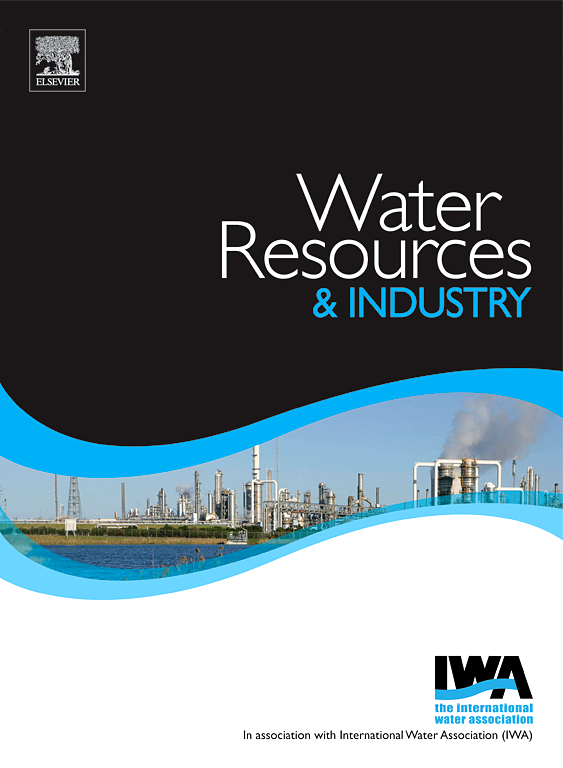A novel chitosan sorbent enriched with nickel ions: An effective approach for eliminating excess phosphate(V) anions in water
IF 4.5
3区 工程技术
Q1 WATER RESOURCES
引用次数: 0
Abstract
Phosphorus is an essential nutrient for living beings. Unfortunately, high phosphate(V) levels can lead to eutrophication in aquatic ecosystems. One promising technique for removing phosphate(V) contamination is sorption, which uses various sorbents. In particular, chitosan, a natural polysaccharide, has gained special attention due to its excellent sorption properties, biocompatibility, and ease of modification. This study proposes a new sorbent, a chitosan-based hydrogel modified with nickel ions (Cs-Ni), for effectively sorbing phosphate(V) anions from both model and natural waters. The maximum sorption capacity of phosphates(V) by the Cs-Ni hydrogel calculated by the Langmuir model was 62.5 mg/g, which was much higher compared to the unmodified chitosan-based hydrogel. The phosphates(V) sorption rate by Cs-Ni hydrogel was best explained by the pseudo-second-order kinetic model, which established the time to reach equilibrium as 24 h. Phosphates(V) desorption to 95 % efficiency was achieved using a 0.1 M NaOH solution. Multi-cycle sorption and desorption studies showed that the Cs-Ni hydrogel can be reused at least five times without any loss of nickel(II) ions from the structure of the sorbent. Most coexisting anions in natural waters had a minor impact on phosphate(V) removal by the Cs-Ni hydrogel, with the exception of sulfate(VI), which reduced the phosphorus removal efficiency by ∼50 %. Modification of chitosan with nickel(II) significantly enhanced its properties for both physical and chemical sorption of phosphate(V) anions. The hydrogel beads’ design allows for easy solid-phase separation from the purified water, making the Cs-Ni hydrogel advantageous for removing phosphates(V) from real aqueous systems.

新型壳聚糖富集镍离子吸附剂:去除水中多余磷酸(V)阴离子的有效方法
磷是生物必需的营养物质。不幸的是,高磷(V)水平会导致水生生态系统富营养化。一种很有前途的去除磷酸盐(V)污染的技术是吸附,它使用各种吸附剂。壳聚糖是一种天然多糖,因其优良的吸附性能、生物相容性和易于改性而受到人们的特别关注。本研究提出了一种新的吸附剂,一种基于壳聚糖的镍离子(Cs-Ni)改性水凝胶,可以有效地从模型和自然水中吸收磷酸盐(V)阴离子。Langmuir模型计算出Cs-Ni水凝胶对磷酸盐的最大吸附量(V)为62.5 mg/g,远高于未改性壳聚糖基水凝胶。Cs-Ni水凝胶对磷酸盐(V)的吸附速率最好用拟二级动力学模型来解释,该模型确定了达到平衡的时间为24 h。在0.1 M NaOH溶液中,磷酸盐(V)的解吸效率达到95%。多循环吸附和解吸研究表明,Cs-Ni水凝胶可以重复使用至少5次,而不会从吸附剂的结构中损失镍(II)离子。天然水中共存的大多数阴离子对Cs-Ni水凝胶去除磷酸盐(V)的影响较小,但硫酸盐(VI)除外,它使除磷效率降低了约50%。对壳聚糖进行镍(II)改性后,壳聚糖对磷酸(V)阴离子的物理吸附和化学吸附性能显著提高。水凝胶珠的设计使纯化水易于固相分离,使Cs-Ni水凝胶有利于从实际水系统中去除磷酸盐(V)。
本文章由计算机程序翻译,如有差异,请以英文原文为准。
求助全文
约1分钟内获得全文
求助全文
来源期刊

Water Resources and Industry
Social Sciences-Geography, Planning and Development
CiteScore
8.10
自引率
5.90%
发文量
23
审稿时长
75 days
期刊介绍:
Water Resources and Industry moves research to innovation by focusing on the role industry plays in the exploitation, management and treatment of water resources. Different industries use radically different water resources in their production processes, while they produce, treat and dispose a wide variety of wastewater qualities. Depending on the geographical location of the facilities, the impact on the local resources will vary, pre-empting the applicability of one single approach. The aims and scope of the journal include: -Industrial water footprint assessment - an evaluation of tools and methodologies -What constitutes good corporate governance and policy and how to evaluate water-related risk -What constitutes good stakeholder collaboration and engagement -New technologies enabling companies to better manage water resources -Integration of water and energy and of water treatment and production processes in industry
 求助内容:
求助内容: 应助结果提醒方式:
应助结果提醒方式:


